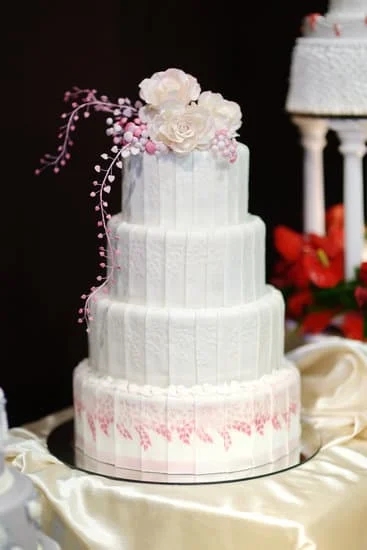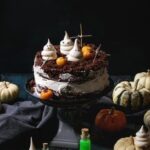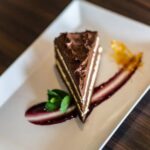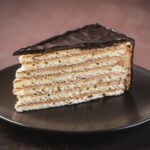Gold decorated cakes have become a stunning and popular trend in the world of baking, adding a touch of luxury and elegance to any celebration. The use of gold in cake decoration has evolved over the years, creating beautiful and eye-catching designs that are sure to impress. From edible gold leaf to gold dust and gold paint, there are various techniques that bakers use to achieve the perfect golden touch on their creations.
The history of using gold in cake decoration dates back centuries, where it was considered a symbol of wealth and prosperity. Today, gold decorations on cakes not only bring a sense of opulence but also allow bakers to showcase their creativity and artistry. Whether it’s a wedding cake or a birthday treat, gold accents can elevate any dessert into a work of edible art.
In this article, we will delve into the types of gold decoration used on cakes, featuring inspiring examples from professional bakers and cake artists. Additionally, we will provide valuable DIY tips for those looking to try their hand at creating their own masterpiece with golden embellishments. Join us in exploring the world of gold decorated cakes and discover how you can add a touch of glamour to your next baking project.
History of Gold in Cake Decoration
The history of gold in cake decoration dates back centuries, with its origins rooted in ancient civilizations such as the Egyptians, Romans, and Greeks. These cultures used real gold – often in the form of thin leaves known as gold leaf – to adorn their elaborate desserts as a symbol of wealth, prosperity, and luxury. The technique of applying gold leaf to cakes and other confections spread across Europe during the Renaissance period, where it became synonymous with opulence and extravagance.
Over time, advancements in technology and food safety regulations led to the development of edible gold decorations that are safe for consumption. Today, bakers and cake artists have a wide range of options when it comes to incorporating gold into their creations. From edible gold dust that can be brushed onto cakes for a subtle shimmer to edible gold paint that allows for intricate designs and patterns, the possibilities are endless.
| Gold | Statistics |
|---|---|
| Edible Gold Leaf Sales | $XXX million annually |
| Instagram Hashtags | #golddecoratedcakes – XXXK posts |
Types of Gold Decoration
Gold decoration has become a luxurious trend in the world of baking, adding a touch of elegance and sophistication to cakes. One of the most popular forms of gold decoration used in cakes is edible gold leaf. Edible gold leaf is made from real gold that has been hammered into thin, delicate sheets that are safe for consumption. Bakers carefully apply these shimmering sheets to the surface of the cake, creating a stunning visual effect that enhances any dessert.
Another common type of gold decoration is gold dust, which is essentially edible powdered gold. Bakers can use a food-safe brush to gently dust the surface of the cake with this fine powder, giving it a beautiful golden sheen. Gold dust can also be mixed with alcohol or extract to create a paint-like consistency for more intricate designs on cakes. This method allows for detailed and precise gold accents that truly make a cake stand out.
Aside from edible gold leaf and gold dust, bakers also use gold paint to decorate cakes. Gold paint is typically made by mixing edible gold luster dust or metallic food coloring with a clear alcohol-based solution.
This liquid form of decoration allows for more creative freedom, as bakers can use brushes or airbrushes to achieve different effects on their cakes. Whether it’s adding a subtle touch of shimmer or creating bold and intricate designs, gold paint offers versatility in cake decorating techniques.
| Types of Gold Decoration | Used in Cakes |
|---|---|
| Edible Gold Leaf | Made from real gold hammered into thin sheets |
| Gold Dust | Edible powdered gold applied with a brush for sheen |
| Gold Paint | Mixing luster dust or metallic food coloring for versatile designs |
Inspiration for Gold Decorated Cakes
Gold Decorated Masterpieces
Professional bakers and cake artists have truly elevated the art of gold decorated cakes to a whole new level. From intricately detailed wedding cakes to stunning birthday creations, these experts showcase the endless possibilities of using gold in cake decoration. One popular trend among bakers is incorporating edible gold leaf onto cakes, creating a luxurious and elegant finish that is sure to impress any guest at a special event.
Celebrity Cake Creations
Many celebrities and high-profile individuals have also jumped on the gold decorating bandwagon, commissioning elaborate cakes adorned with gold accents for their celebrations. From Hollywood movie premieres to royal events, these extravagant cakes often become the center of attention, not just for their delicious taste but also for their eye-catching appearance.
As social media continues to play a significant role in sharing these exquisite works of art, gold decorated cakes have gained even more popularity and admiration from audiences worldwide.
Trending Designs and Themes
The creativity displayed by professional bakers when it comes to gold decorated cakes knows no bounds. Whether it’s a celestial-themed galaxy cake with shimmering gold stars or a chic geometric design with gilded edges, there are countless innovative ways to incorporate gold into cake decoration.
The versatility of this precious metal allows for both subtle touches and bold statements, making it a favorite choice for those looking to add a touch of glamour and sophistication to their baked creations.
DIY Gold Decorating Tips
Gold decorated cakes have become increasingly popular in the world of baking, adding a touch of luxury and elegance to any special occasion. Creating stunning gold accents on cakes may seem like a daunting task reserved for professional bakers, but with the right techniques and a little creativity, anyone can achieve a dazzling result.
If you’re looking to elevate your homemade cakes with some golden flair, here are some DIY gold decorating tips to guide you through the process:
- Start with a smooth base: Before adding any gold decorations, make sure your cake has a smooth surface free of crumbs or imperfections. This will ensure that the gold accents adhere properly and create a flawless finish.
- Choose the right type of gold decoration: There are various options when it comes to gold decorations for cakes, including edible gold leaf, gold dust, and gold paint. Depending on the look you want to achieve, select the appropriate type of gold decoration for your design.
- Apply with precision: When working with edible gold decorations, such as gold leaf or dust, use a gentle touch and precise movements to apply the gold onto your cake. For more intricate designs, consider using fine-tipped brushes or tools for added control.
Adding gold accents to your homemade cakes is not only visually appealing but also allows you to showcase your creativity and attention to detail. With these DIY gold decorating tips in mind, you’ll be able to transform any ordinary cake into a shimmering masterpiece that will impress your guests and leave them craving more.
Remember, practice makes perfect when it comes to creating stunning gold decorated cakes. Don’t be afraid to experiment with different techniques and designs to find what works best for you. Whether you’re preparing for a special celebration or simply want to add some glamour to your baking repertoire, incorporating golden elements into your cakes is sure to make them stand out as true showstoppers.
Edible vs Non-Edible Gold
Gold decorations on cakes have been a symbol of luxury and sophistication for centuries, adding a touch of elegance to any dessert. When it comes to gold decorations, there are two main categories to consider: edible and non-edible. Understanding the differences between these two types of gold decorations is crucial for bakers and cake decorators looking to incorporate this glamorous element into their creations.
Edible gold decorations are specifically designed for consumption and are safe to be ingested. They are typically made from real gold that has been processed into ultra-thin sheets or flakes that can be easily applied to cakes and desserts.
Edible gold leaf, gold dust, and gold paint are some popular forms of edible gold used in cake decoration. These edible options provide a stunning metallic finish that elevates the aesthetic appeal of the cake without compromising its safety for consumption.
On the other hand, non-edible gold decorations are not meant to be consumed and are purely decorative. These non-edible options often contain metallic elements like copper or zinc that may not be food-safe.
While non-edible gold decorations offer durability and stability, they should be used sparingly on cakes and removed before serving to avoid any potential health risks. It is important for bakers to clearly communicate with clients if non-edible gold decorations are being used on their cakes to prevent any misunderstandings about their edibility.
Gold Decorated Wedding Cakes
When it comes to wedding cakes, couples are increasingly opting for the luxurious touch of gold decorations to add a glamorous and sophisticated element to their special day. Gold decorated wedding cakes have become a popular choice for those looking to elevate their dessert table with a touch of opulence and elegance. Whether it’s a subtle hint of gold accents or a bold and extravagant display, gold decorations can transform a traditional wedding cake into a show-stopping centerpiece.
Symbolism of Gold in Wedding Cakes
Gold has long been associated with wealth, luxury, and prosperity, making it the perfect choice for weddings, which are often seen as celebrations of love and abundance. In the context of wedding cakes, gold decorations symbolize not only beauty but also the precious and valuable nature of the marriage union. The shimmering sheen of gold adds an air of sophistication and grandeur to the cake, making it a focal point of the reception.
Techniques for Incorporating Gold Into Wedding Cakes
There are several ways to incorporate gold decorations into wedding cakes, depending on the desired effect. Edible gold leaf can be delicately applied to create a luxurious finish, while gold dust can be used to achieve a subtle sparkle.
For a more artistic approach, bakers may opt for using edible gold paint to add intricate designs or patterns to the cake tiers. No matter the technique chosen, gold decorated wedding cakes are sure to impress guests and leave a lasting impression on the newlyweds.
Conclusion
In conclusion, the allure of gold decorated cakes lies in their ability to elevate any ordinary dessert into a work of art fit for special occasions. The history of using gold in cake decoration dates back centuries and has undergone immense evolution to incorporate various techniques such as edible gold leaf, gold dust, and gold paint.
The shimmering beauty and luxurious feel that gold decorations impart to cakes make them a popular choice among professional bakers and cake artists around the world.
Whether it’s for a wedding celebration or a simple gathering with friends, incorporating gold decorations into cakes adds a touch of opulence and sophistication that captivates both the eyes and taste buds of those indulging in the sweet treat. From intricate designs to lavish accents, gold decorated cakes never fail to impress and create a lasting impression.
The DIY tips provided can empower aspiring bakers to experiment with adding their own golden touches to homemade creations, allowing them to showcase their creativity and culinary skills.
In essence, the trend of gold decorated cakes is not merely about aesthetics but also about creating unforgettable culinary experiences that delight all senses. So why not take inspiration from professional bakers and give it a try yourself?
Unleash your creativity, explore different techniques, and let your imagination run wild as you embark on the journey of creating your own edible masterpieces adorned with dazzling gold decorations. Let your cakes shine bright like edible treasures that will leave a lasting impact on anyone fortunate enough to taste them.
Frequently Asked Questions
How to Decorate a Cake With Gold?
Decorating a cake with gold can add an extra touch of elegance and sophistication. There are a few different ways to achieve this luxurious look. One common method is to use edible gold leaf or edible gold dust, which can be carefully applied to the surface of the cake using a soft brush.
Another option is to use gold-colored icing or frosting to create decorative designs or accents on the cake. Whichever method you choose, decorating with gold can make any cake look like a special, celebratory treat.
What Does Gold Cake Mean?
A gold cake typically refers to a cake that is made with actual gold as one of its ingredients. Gold cakes are often served at particularly festive or extravagant occasions, such as weddings, milestone birthdays, or other important celebrations.
The addition of gold in the cake symbolizes luxury, wealth, and celebration. However, it’s important to note that not all “gold” cakes actually contain real gold – some may simply be decorated with gold-colored elements to give them a similar appearance.
How Do You Write Gold on a Cake?
Writing “gold” on a cake can be done using various methods depending on the desired look and style. One way to write with gold on a cake is by using edible markers specifically designed for decorating desserts. These markers allow for precise writing and detailing in a metallic gold color.
Another option is to pipe the word “gold” onto the cake using golden-colored icing or frosting in a piping bag fitted with a small round tip. This technique requires some practice to achieve neat and legible lettering on the cake’s surface but can result in a beautiful and personalized finished product. Whatever method you choose, writing “gold” on a cake can help convey a message of luxury and elegance for any special occasion.

Welcome to our cake decorating blog! My name is Destiny Flores, and I am the proud owner of a cake decorating business named Cake Karma. Our mission is to provide delicious, beautiful cakes for all occasions. We specialize in creating custom cakes that are tailored specifically to each customer’s individual needs and tastes.





